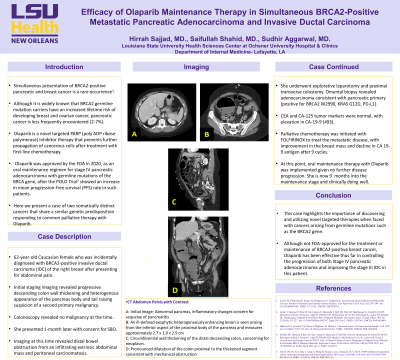Sunday Poster Session
Category: Biliary/Pancreas
P0146 - Efficacy of Olaparib Maintenance Therapy in Simultaneous BRCA2-Positive Metastatic Pancreatic Adenocarcinoma and Invasive Ductal Carcinoma
Sunday, October 22, 2023
3:30 PM - 7:00 PM PT
Location: Exhibit Hall

Has Audio

Hirrah Sajjad, MD
Ochsner University Hospital & Clinics; LSUHSC-Lafayette
Kingston, MA
Presenting Author(s)
Hirrah Sajjad, MD1, Saifullah Shahid, MD2, Sudhir Aggarwal, MD2
1Ochsner University Hospital & Clinics; LSUHSC-Lafayette, Lafayette, LA; 2Ochsner University Hosital & Clinics, Lafayette, LA
Introduction: Simultaneous presentation of BRCA2-positive pancreatic and breast cancer is a rare occurrence1. Although it is widely known that BRCA2 germline mutation carriers have an increased lifetime risk of developing breast and ovarian cancer, pancreatic cancer is less frequently encountered (2-7%). Olaparib is a novel targeted PARP (poly ADP ribose polymerase) inhibitor therapy that prevents further propagation of cancerous cells after treatment with first-line chemotherapy. Olaparib was approved by the FDA in 2020, as an oral maintenance regimen for stage IV pancreatic adenocarcinoma with germline mutations of the BRCA gene, after the POLO Trial2 showed an increase in mean progression-free survival (PFS) rate in such patients. Here we present a case of two somatically distinct cancers that share a similar genetic predisposition responding to palliative therapy with Olaparib.
Case Description/Methods: Here we present a 62-year-old female who was incidentally diagnosed with BRCA2-positive invasive ductal carcinoma (IDC) of the right breast after presenting for abdominal pain. Initial staging imaging revealed progressive descending colon wall thickening and heterogenous appearance of the pancreas body and tail raising suspicion of a second primary malignancy. Colonoscopy revealed no malignancy. She presented 1-month later with concern for SBO. Imaging revealed distal bowel obstruction from an infiltrating extrinsic abdominal mass and peritoneal carcinomatosis. She underwent explorative laparotomy and proximal transverse colostomy. Omental biopsy revealed adenocarcinoma consistent with pancreatic primary (positive for BRCA2 W2990, KRAS G12D, PD-L1). CEA and CA-125 tumor markers were normal, with elevation in CA-19-9 (493). Palliative chemotherapy was initiated with FOLFIRINOX to treat the metastatic disease, with improvement in the breast mass and decline in CA 19-9 antigen after 9 cycles. At this point, oral maintenance therapy with Olaparib was implemented given no further disease progression. She is now 5 months into the maintenance stage and clinically doing well.
Discussion: This case highlights the importance of discovering and utilizing novel targeted therapies when faced with cancers arising from germline mutations such as the BRCA2 gene. Although not FDA-approved for the treatment or maintenance of BRCA2-positive breast cancer, Olaparib has been effective thus far in controlling the progression of both Stage IV pancreatic adenocarcinoma and improving the stage III IDC in this patient.
Disclosures:
Hirrah Sajjad, MD1, Saifullah Shahid, MD2, Sudhir Aggarwal, MD2. P0146 - Efficacy of Olaparib Maintenance Therapy in Simultaneous BRCA2-Positive Metastatic Pancreatic Adenocarcinoma and Invasive Ductal Carcinoma, ACG 2023 Annual Scientific Meeting Abstracts. Vancouver, BC, Canada: American College of Gastroenterology.
1Ochsner University Hospital & Clinics; LSUHSC-Lafayette, Lafayette, LA; 2Ochsner University Hosital & Clinics, Lafayette, LA
Introduction: Simultaneous presentation of BRCA2-positive pancreatic and breast cancer is a rare occurrence1. Although it is widely known that BRCA2 germline mutation carriers have an increased lifetime risk of developing breast and ovarian cancer, pancreatic cancer is less frequently encountered (2-7%). Olaparib is a novel targeted PARP (poly ADP ribose polymerase) inhibitor therapy that prevents further propagation of cancerous cells after treatment with first-line chemotherapy. Olaparib was approved by the FDA in 2020, as an oral maintenance regimen for stage IV pancreatic adenocarcinoma with germline mutations of the BRCA gene, after the POLO Trial2 showed an increase in mean progression-free survival (PFS) rate in such patients. Here we present a case of two somatically distinct cancers that share a similar genetic predisposition responding to palliative therapy with Olaparib.
Case Description/Methods: Here we present a 62-year-old female who was incidentally diagnosed with BRCA2-positive invasive ductal carcinoma (IDC) of the right breast after presenting for abdominal pain. Initial staging imaging revealed progressive descending colon wall thickening and heterogenous appearance of the pancreas body and tail raising suspicion of a second primary malignancy. Colonoscopy revealed no malignancy. She presented 1-month later with concern for SBO. Imaging revealed distal bowel obstruction from an infiltrating extrinsic abdominal mass and peritoneal carcinomatosis. She underwent explorative laparotomy and proximal transverse colostomy. Omental biopsy revealed adenocarcinoma consistent with pancreatic primary (positive for BRCA2 W2990, KRAS G12D, PD-L1). CEA and CA-125 tumor markers were normal, with elevation in CA-19-9 (493). Palliative chemotherapy was initiated with FOLFIRINOX to treat the metastatic disease, with improvement in the breast mass and decline in CA 19-9 antigen after 9 cycles. At this point, oral maintenance therapy with Olaparib was implemented given no further disease progression. She is now 5 months into the maintenance stage and clinically doing well.
Discussion: This case highlights the importance of discovering and utilizing novel targeted therapies when faced with cancers arising from germline mutations such as the BRCA2 gene. Although not FDA-approved for the treatment or maintenance of BRCA2-positive breast cancer, Olaparib has been effective thus far in controlling the progression of both Stage IV pancreatic adenocarcinoma and improving the stage III IDC in this patient.
Disclosures:
Hirrah Sajjad indicated no relevant financial relationships.
Saifullah Shahid indicated no relevant financial relationships.
Sudhir Aggarwal indicated no relevant financial relationships.
Hirrah Sajjad, MD1, Saifullah Shahid, MD2, Sudhir Aggarwal, MD2. P0146 - Efficacy of Olaparib Maintenance Therapy in Simultaneous BRCA2-Positive Metastatic Pancreatic Adenocarcinoma and Invasive Ductal Carcinoma, ACG 2023 Annual Scientific Meeting Abstracts. Vancouver, BC, Canada: American College of Gastroenterology.
